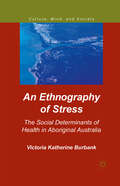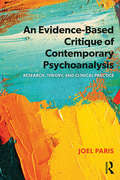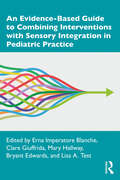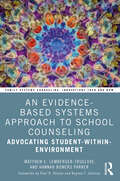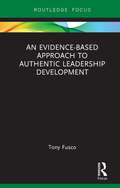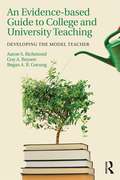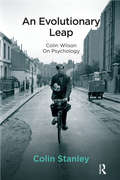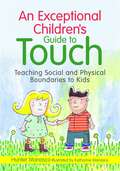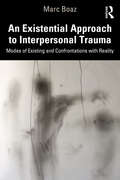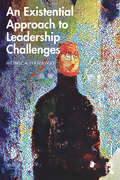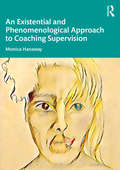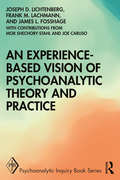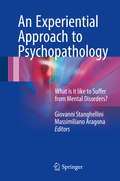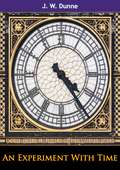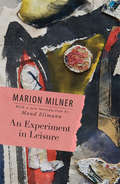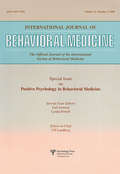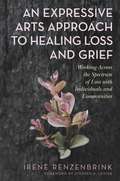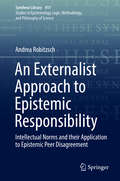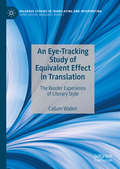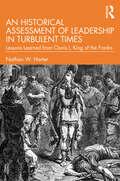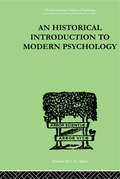- Table View
- List View
An Ethnography of Stress: The Social Determinants of Health in Aboriginal Australia (Culture, Mind, and Society)
by Victoria Katherine BurbankThis book examines the global issue of health inequality through an in-depth look at a remote Australian Aboriginal community characterized by premature morbidity and mortality.
An Ethology of Religion and Art: Belief as Behavior (Routledge Studies in Religion)
by Bryan RennieDrawing from sources including the ethology of art and the cognitive science of religion this book proposes an improved understanding of both art and religion as behaviors developed in the process of human evolution. Looking at both art and religion as closely related, but not identical, behaviors a more coherent definition of religion can be formed that avoids pitfalls such as the Eurocentric characterization of religion as belief or the dismissal of the category as nothing more than false belief or the product of scholarly invention. The book integrates highly relevant insights from the ethology and anthropology of art, particularly the identification of "the special" by Ellen Dissanayake and art as agency by Alfred Gell, with insights from, among others, Ann Taves, who similarly identified "specialness" as characteristic of religion. It integrates these insights into a useful and accurate understanding and explanation of the relationship of art and religion and of religion as a human behavior. This in turn is used to suggest how art can contribute to the development and maintenance of religions. The innovative combination of art, science, and religion in this book makes it a vital resource for scholars of Religion and the Arts, Aesthetics, Religious Studies, Religion and Science and Religious Anthropology.
An Evidence-Based Critique of Contemporary Psychoanalysis: Research, Theory, and Clinical Practice (Psychological Issues)
by Joel ParisAn Evidence-Based Critique of Contemporary Psychoanalysis assesses the state of psychoanalysis in the 21st century. Joel Paris examines areas where analysis needs to develop a stronger scientific and clinical base, and to integrate its ideas with modern clinical psychology and psychiatry. While psychoanalysis has declined as an independent discipline, it continues to play a major role in clinical thought. Paris explores the extent to which analysis has gained support from recent empirical research. He argues that it could revive its influence by establishing a stronger relationship to science, whilst looking at the state of current research. For clinical applications, he suggests while convincing evidence is lacking to support long-term treatment, brief psychoanalytic therapy, lasting for a few months, has been shown to be relatively effective for common mental disorders. For theory, Paris reviews changes in the psychoanalytic paradigm, most particularly the shift from a theory based largely on intrapsychic mechanisms to the more interpersonal approach of attachment theory. He also reviews the interfaces between psychoanalysis and other disciplines, ranging from "neuropsychoanalysis" to the incorporation of analytic theory into post-modern models popular in the humanities. An Evidence-Based Critique of Contemporary Psychoanalysis concludes by examining the legacy of psychoanalysis and making recommendations for integration into broader psychological theory and psychotherapy. It will be of great interest to psychoanalysts, psychoanalytic psychotherapists, and scholars and practitioners across the mental health professions interested in the future and influence of the field.
An Evidence-Based Guide to Combining Interventions with Sensory Integration in Pediatric Practice
by Erna Imperatore Blanche Clare Giuffrida Mary Hallway Bryant Edwards Lisa A. TestThis book offers practical ideas on the combination of sensory integration theory principles with other evidence-based approaches in the evaluation and treatment of multifaceted issues in children with disabilities. Using the ICF Model, a Clinical Reasoning Model, and featuring numerous case studies, the opening chapters focus on the evidence for combining intervention approaches with diagnoses most often encountered in clinical practice. The latter half of the book covers the delivery of services using blended intervention approaches in different settings, such as the school, the hospital, and in nature. Featured are existing community programs illustrating the combination of approaches in practice. Appendices include reproducible resources, a guide to assessments, and approaches. The text will guide occupational therapists and other health professionals working with children and adolescents across a variety of settings in using clinical reasoning skills in a systematic manner that will lead to better interventions.
An Evidence-Based Systems Approach to School Counseling: Advocating Student-within-Environment (Family Systems Counseling: Innovations Then and Now)
by Matthew E. Lemberger-Truelove Hannah Bowers ParkerThis book presents strategies for using systemic theory and evidence-based practice in schools to support students, the adults in their lives, and their wider communities. Beginning by introducing and explaining the Advocating Student-within-Environment (ASE) theory, each chapter then addresses a specific school-based issue, such as academic achievement, crisis, trauma, and resiliency, from a systemic and environmental lens. Practical and accessible, the chapters are filled with case examples, evidence-based interventions, and helpful tools to show how counselors can incorporate the approach into their practice. Extending beyond school and student problems, this text also explores greater system functioning, such as community outreach and state level intervention, discussing advocacy and political issues. This book is essential for school-based professionals who are looking for new ways to work with students, families, and their communities. It will also be of interest to mental health professionals who work systemically, such as marriage and family therapists and community counselors.
An Evidence-based Approach to Authentic Leadership Development (Routledge Focus on Mental Health)
by Tony FuscoThis book presents the first evidence-based approach to Authentic Leadership Development. It is based on a group-coaching format that brings together small groups of leaders to discuss personally significant leadership issues generally not explored in usual leadership development, such as the influence of their personal histories, the impact of their psychological make-up, and the ambitions for their future leadership. The book starts with an overview of the idea of authenticity and its philosophical roots, and explains how this informs the past/present/future group-coaching approach to Authentic Leadership Development. It presents statistical and conceptual evidence of the program’s efficacy and explores how the social processes at work within the group positively impact and develop the leader’s self-concept and the benefits this brings. Importantly, it also details exactly how the leader changes and grows as a result of the group-coaching, and the positive ways in which this benefits their leadership role and the organisations they work in. Finally, it questions the notion of ethics and morals in Authentic Leadership and critically re-appraises the idea of leadership development evaluation. Authentic Leadership Development group-coaching has been shown to develop leaders that are conscious, competent, confident and congruent and as the qualitative analysis presented in the book illustrates, these 4 over-arching categories are made up of 7 further key leadership attributes that are developed, which include an enhanced Strategic Orientation, increased Confidence and Clarity and greater Management Mindfulness, among others. The book also features personal vignettes throughout, which illustrate how individual leaders have effectively applied these newly developed attributes in their leadership roles. An Evidence-based Approach to Authentic Leadership Development represents essential reading for leaders who want to engage in a ‘proven’ form of ALD. It will be of great interest to professionals across a variety of industries who have responsibility to provide robust leadership development programs for their organisations, as well as coaches specialising in executive, business and leadership coaching and those interested in new applications for group coaching.
An Evidence-based Guide to College and University Teaching: Developing the Model Teacher
by Aaron S. Richmond Regan A. Gurung Guy A. BoysenAn Evidence-based Guide to College and University Teaching outlines a definition of "model teaching" based on research evidence and accepted best practices in high education. Teachers at all levels of skill and experience can benefit from clear, objective guidelines for defining and measuring quality teaching. To fulfil this need, this book outlines six fundamental areas of teaching competency—model teaching characteristics—and provides detailed definitions of each characteristic. The authors define these essential characteristics as training, course content, the assessment process, instructional methods, syllabus construction, and the use of student evaluations. This guide outlines through research and supplemental evidence how each characteristic can be used toward tenure, promotion, teaching portfolios, and general professional development. Additional features include a self-assessment tool that corresponds to the model teaching characteristics, case studies illustrating common teaching problems, and lists of "must reads" about college teaching. An Evidence-based Guide to College and University Teaching describes how college faculty from all disciplines and at all levels of their career – from graduate students to late-career faculty – can use the model teaching characteristics to evaluate, guide, and improve their teaching. The book is additionally useful for teachers, trainers, and administrators responsible for promoting excellence in college teaching.
An Evidence-based Guide to College and University Teaching: Developing the Model Teacher
by Aaron S. Richmond Guy A. Boysen Regan A GurungWhat makes a good college teacher? This book provides an evidence- based answer to that question by presenting a set of "model teaching characteristics" that define what makes a good college teacher. Based on six fundamental areas of teaching competency known as Model Teaching Characteristics outlined by The Society for the Teaching of Psychology (STP), this book describes how college faculty from all disciplines and at all levels of experience can use these characteristics to evaluate, guide, and improve their teaching. Evidence based research supports the inclusion of each characteristic, each of which is illustrated through example, to help readers master the skills. Readers learn to evaluate their teaching abilities by providing guidance on what to document and how to accumulate and organize the evidence. Two introductory chapters outline the model teaching characteristics followed by six chapters, each devoted to one of the characteristics: training, instructional methods, course content, assessment, syllabus construction, and student evaluations. The book: -Features in each chapter self-evaluation surveys that help readers identify gaps between the model characteristics and their own teaching, case studies that illustrate common teaching problems, discussion questions that encourage critical thinking, and additional readings for further exploration. -Discusses the need to master teaching skills such as collaborative learning, listening, and using technology as well as discipline-specific knowledge. -Advocates for the use of student-learning outcomes to help teachers better evaluate student performance based on their achievement of specific learning goals. -Argues for the development of learning objectives that reflect the core of the discipline‘s theories and applications, strengthen basic liberal arts skills, and infuse ethical and diversity issues. -Discusses how to solicit student feedback and utilize these evaluations to improve teaching. Intended for professional development or teacher training courses offered in masters and doctoral programs in colleges and universities, this book is also an invaluable resource for faculty development centers, college and university administrators, and college teachers of all levels and disciplines, from novice to the most experienced, interested in becoming more effective teachers.
An Evolutionary Leap: Colin Wilson on Psychology
by Colin StanleyWhen the existential philosopher Colin Wilson died in December 2013, it was suggested by one perceptive obituary writer that, despite the seemingly diverse subject matter of his books, his true legacy lay in the field of Consciousness Studies. This is particularly apparent when studying his many essays and books on psychology and taking into consideration his close association with the celebrated American psychologist Abraham Maslow whose concept of 'Peak Experiences'(PEs) became, for Wilson, an important link to experiencing enhanced consciousness. Maslow, however, felt that PEs could not be induced at will; Wilson thought otherwise and through his work sought to encourage his readers and students to live more vital and appreciative lives thereby paving the way toward an evolutionary leap for mankind in consciousness-indeed, a change in consciousness that would potentially change everything.In this study, Colin Stanley, Wilson's bibliographer and author of Colin Wilson's 'Outsider Cycle': A Guide for Students and Colin Wilson's 'Occult Trilogy': A Guide for Students, provides an illuminating essay on each of Wilson's nine major books on psychology.
An Exceptional Children's Guide to Touch: Teaching Social and Physical Boundaries to Kids
by McKinley Hunter ManascoThe rules of physical contact can be tricky to grasp and children with special needs are at a heightened risk of abuse. This friendly picture book explains in simple terms how to tell the difference between acceptable and inappropriate touch, thereby helping the child with special needs stay safe. <P><P>Each story covers a different type of touch from accidental to friendly to hurtful and will help children understand how boundaries change depending on the context. It explores when and where it is okay to touch other people, when and where other people can touch you, why self touching sometimes needs to be private, and what to do if touch feels inappropriate. <P><P>This book is an invaluable teaching resource and discussion starter for parents, teachers and carers working with children with special needs.
An Existential Approach to Interpersonal Trauma: Modes of Existing and Confrontations with Reality
by Marc BoazAn Existential Approach to Interpersonal Trauma provides a new existential framework for understanding the experiences of interpersonal trauma building on reflections from Marc Boaz’s own personal history, clinical insight and research. The book suggests that psychology, psychotherapy and existentialism do not recognise the significance of the existential movements that occur in traumatic confrontations with reality. By considering what people find at the limits and boundaries of human experiencing, Boaz describes the ways in which they can disillusion and re-illusion themselves, and how this becomes incorporated into their modes of existing in the world and in relation to others. In incorporating the experience of trauma into the way people live – all the existential horror, terror and liberation contained within it – Boaz invites them to embrace an expansive ethic of (re)(dis)covery. This ethic recognises the ambiguity and spectrality of interpersonal trauma, and expands the horizons of our human relationships. The book provides an important basis for professionals wanting to work existentially with interpersonal trauma and for people wanting to deepen their understanding of the trauma they have experienced.
An Existential Approach to Leadership Challenges
by Monica HanawayIn An Existential Approach to Leadership Challenges, Monica Hanaway progresses us forward from a brief, introductory understanding of existential thought to considering how this approach can positively address the practical leadership challenges our twenty-first century leaders face today. Hanaway presents a practical framework to tackle the greatest challenges in leadership, such as creating an inspiring and authentic vision, recruiting, retaining and developing staff and dealing with conflict. In Part I, she presents an overview of existential thought and what existentialism can bring to leadership, helping resolve issues of uncertainty, authenticity, relatedness, freedom and meaning making. In Part II, she explores how to work practically with an existential leadership approach, showing how existentialism can help communicate a vision, examining the vision statements of existing businesses as case studies and explaining the importance of this in recruiting, developing and retaining staff. Finally, she explores how the existential approach is beneficial in preventing, managing and dealing with conflict, defining what conflict is and introducing existentially informed conflict coaching and psychologically informed mediation practice. Combining philosophical and practical thinking, Hanaway has made existentialism an accessible resource for all leaders. This book will appeal to future leaders in practice and in training, and anyone in a leadership role. It will also be of interest to academics and students of coaching and coaching psychology, as well as to those interested in applied philosophy and psychology.
An Existential and Phenomenological Approach to Coaching Supervision
by Monica HanawayAs the methodology for coaching supervision has grown and developed in recent years, so too has the need for comprehensive engagement with the needs of supervisees. This ground-breaking and much-needed new book from Monica Hanaway presents a unique existential approach to coaching supervision. This book includes an introduction to the model, with emphasis on the philosophical focus of the existential coaching approach and concepts such as uncertainty, freedom, emotions, values and beliefs, meaning and relatedness. Hanaway offers supervisors ways of working with their supervisees on each of the key existential themes, as well as a comparison with other coaching supervision models. This book describes how a supervisor can bring an existential approach into their work, both with existential coaches and with those working in different modalities who are interested in adding to their portfolio of service. It will be of immense value to academics and students of coaching psychology.
An Experience-based Vision of Psychoanalytic Theory and Practice: Seeking, Feeling, and Relating (Psychoanalytic Inquiry Book Series)
by Joseph D. Lichtenberg Frank M. Lachmann James L FosshageAn Experience-based Vision of Psychoanalytic Theory and Practice looks at each individual as a motivated doer doing, seeking, feeling, and intending, and relates development, sense of self, and identity to changes that are brought about in analytic psychotherapy. Based on conceptualizing experience as it is lived from infancy throughout life, this book identifies three major pathways to development and applies Lichtenberg, Lachmann, and Fosshage’s experience-based vision to psychoanalytic psychotherapy. Using detailed clinical narratives and vignettes, as well as organizational studies, the book takes up the distinction between a person’s responding to a failure in achieving a goal with disappointment and seeking an alternative path, or with disillusion and a collapse in motivation. From the variety of topics covered, the reader will get a broad overview of an experience-based analytic conception of motivation begun with Lichtenberg’s seven motivational systems. This title will be of great interest to established psychoanalysts, as well as those training in psychoanalysis and clinical counselling psychology programs.
An Experiential Approach to Psychopathology: What is it like to Suffer from Mental Disorders?
by Giovanni Stanghellini Massimiliano AragonaThis book introduces the reader to a clear and consistent method for in-depth exploration of subjective psychopathological experiences with the aim of helping to restore the ability within psychiatry and clinical psychology to draw qualitative distinctions between mental symptoms that are only apparently similar, thereby promoting a more precise characterization of experiential phenotypes. A wide range of mental disorders are considered in the book, each portrayed by a distinguished clinician. Each chapter begins with the description of a paradigmatic case study in order to introduce the reader directly to the patient's lived world. The first-person perspective of the patient is the principal focus of attention. The essential, defining features of each psychopathological phenomenon and the meaning that the patient attaches to it are carefully analyzed in order to "make sense" of the patient's apparently nonsensical experiences. In the second part of each chapter, the case study is discussed within the context of relevant literature and a detailed picture of the state of the art concerning the psychopathological understanding of the phenomenon at issue is provided. An Experiential Approach to Psychopathology, and the method it proposes, may be considered the result of convergence of classic phenomenological psychopathological concepts and updated clinical insights into patients' lived experiences. It endorses three key principles: subjective phenomena are the quintessential feature of mental disorders; their qualitative study is mandatory; phenomenology has developed a rigorous method to grasp "what it is like" to be a person experiencing psychopathological phenomena. While the book is highly relevant for expert clinical phenomenologists, it is written in a way that will be readily understandable for trainees and young clinicians.
An Experiment With Time
by J. W. DunneA book by the British aeronautical engineer J. W. Dunne (1875-1949) on the subjects of precognitive dreams and the nature of time. First published in March 1927, it was very widely read, and his ideas were promoted by several other authors, in particular by J. B. Priestley. He published three sequels; The Serial Universe, The New Immortality, and Nothing Dies.
An Experiment in Leisure
by Marion MilnerWhat is it that stops people from knowing what they want? How often do we wonder where we are going and what our world is all about? Written in 1936 as a companion piece to A Life of One’s Own, An Experiment in Leisure further charts Marion Milner’s illuminating and rewarding investigation into how we lead our lives. Instead of drawing on her daily diary, she turns to memory images – images not only from her own life but also from books, mythology, travel and religion that seem to point to a suspension of ordinary, everyday awareness. From this condition of emptiness springs an increasing imaginative appreciation both of being alive and of the world we live in. With a new introduction by Maud Ellmann, An Experiment in Leisure remains a great adventure in thinking and living and will be essential reading for all those from a literary, an artistic, a historical, an educational or a psychoanalytic/psychotherapeutic background.
An Experiment in Leisure (Routledge Classics)
by Marion Milner'Before I began this experiment I had always been haunted by the feeling that the surface of life, what everyone said about it, was quite different from the reality of life, that the important things that were happening all the time were on the whole quite different from what was said about them.' - Marion MilnerWhat is it that stops people from knowing what they want? How much of our experience is shaped by images, symbols, and early memories – and do such things help or hinder one becoming an adult? Written in 1936, An Experiment in Leisure continues Marion Milner’s unique and compelling investigation into how we lead our lives, complementing the account she began in A Life of One’s Own.Attempting to understand the gap between what she memorably describes as ‘the poverty of words and the reality of living’, she draws on memory images – in books, mythology, religious experience, travel, and even going to the theatre – that seem to point to a suspension of ordinary, everyday awareness. From this state of emptiness springs an increasing imaginative appreciation of being alive and, as Milner concludes, of being a woman.With a new Foreword by Akshi Singh, An Experiment in Leisure remains a striking and captivating adventure in thinking and living with uncertainty, whose insights remain fresh and relevant today.
An Exploration of the Health Benefits of Factors That Help Us to Thrive: A Special Issue of the International Journal of Behavioral Medicine
by Gail Ironson Lynda PowellFirst published in 2005. Routledge is an imprint of Taylor & Francis, an informa company.
An Expressive Arts Approach to Healing Loss and Grief: Working Across the Spectrum of Loss with Individuals and Communities
by Irene RenzenbrinkDrawing on expertise in both expressive arts and grief counselling, this book highlights the use of expressive arts therapeutic methods in confronting and healing grief and bereavement. Establishing a link between these two approaches, it widens our understanding of loss and grief.With personal and professional insight, Renzenbrink illuminates the healing and restorative power of creative arts therapies, as well as addressing the impact of communion with others and the role that expressive arts can play in community change. Covering a broad understanding of grief, the discussion incorporates migration and losing one's home, chronic illness and natural disasters, highlighting the breadth of types of loss and widening our perceptions of this. Grief specialists are given imaginative and nourishing tools to incorporate into their practice and better support their clients.An invaluable resource to expand understanding of grief and explore the power of expressive arts to heal both communities and individuals.
An Externalist Approach to Epistemic Responsibility: Intellectual Norms and their Application to Epistemic Peer Disagreement (Synthese Library #411)
by Andrea RobitzschThis monograph provides a novel reliabilist approach to epistemic responsibility assessment. The author presents unique arguments for the epistemic significance of belief-influencing actions and omissions. She grounds her proposal in indirect doxastic control.The book consists of four chapters. The first two chapters look at the different ways in which an agent might control the revision, retention, or rejection of her beliefs. They provide a systematic overview of the different approaches to doxastic control and contain a thorough study of reasons-responsive approaches to direct and indirect doxastic control.The third chapter provides a reliabilist approach to epistemic responsibility assessment which is based on indirect doxastic control.In the fourth chapter, the author examines epistemic peer disagreement and applies her reliabilist approach to epistemic responsibility assessment to this debate. She argues that the epistemic significance of peer disagreement does not only rely on the way in which an agent should revise her belief in the face of disagreement, it also relies on the way in which an agent should act.This book deals with questions of meliorative epistemology in general and with questions concerning doxastic responsibility and epistemic responsibility assessment in particular. It will appeal to graduate students and researchers with an interest in epistemology.
An Eye-Tracking Study of Equivalent Effect in Translation: The Reader Experience of Literary Style (Palgrave Studies in Translating and Interpreting)
by Callum WalkerThis book provides a detailed example of an eye-tracking method for comparing the reading experience of a literary source text readers with readers of a translation at stylistically marked points. Drawing on principles, methods and inspiration from fields including translation studies, cognitive psychology, and language and literary studies, the author proposes an empirical method to investigate the notion of stylistic foregrounding, with 'style' understood as the distinctive manner of expression in a particular text. The book employs Raymond Queneau’s Zazie dans le métro (1959) and its English translation Zazie in the Metro (1960) as a case study to demonstrate the proposed methods. This book will be of particular interest to students and scholars of translation studies, as well as those interested in literary reception, stylistics and related fields.
An Historical Assessment of Leadership in Turbulent Times: Lessons Learned from Clovis I, King of the Franks (Leadership: Research And Practice Ser.)
by Nathan W. HarterThis unique book provides lessons on how to affect good leadership in turbulent times by taking a historical lens and examining the life and impact of Clovis I, King of the Franks. Through the exploration of how this individual managed the unstable times where so many others had failed, the book provides an original take on leadership, focusing on the ways we can learn from and be inspired by his history. This book offers an insightful and detailed case study of Clovis I, as it explores his struggles and triumphs in the face of turbulent times. The book presents implications for students of leadership today and examines why the story of Clovis I reveals the salience of leadership during times of uncertainty and change. Ultimately, the author foresees the rise of myriad leaders trying to manage the upheaval in the twenty-first century, with the likelihood that somebody like Clovis I will emerge, pursuing ambition and re-ordering civilization on a colossal scale, leaving a legacy that will endure for a further thousand years. This book will be of interest to leadership and history scholars and advanced students in Leadership studies.
An Historical Introduction To Modern Psychology (International Library Of Psychology Ser.)
by Murphy, GardnerFirst published in 1999. Routledge is an imprint of Taylor & Francis, an informa company.
An Honest Life: Faithful and Gay
by Geoffrey HooperAn Honest Life is a poignant memoir – much more than a gay coming-out story. With searing honesty the author tries to discover why he first resisted a call to ordination and denied his repressed sexuality. He examines the unconscious defences and cultural pressures which kept him in a heterosexual marriage, and condemns the intolerance and hypocrisy he encountered within the established church, while applauding the support he received from some bishops. The book is enriched by personal stories, contributions from other protagonists, and by the author drawing on a literary reservoir of fellow pilgrims' journeys of faith and evolutionary growth towards integrity over sexual identity. Most movingly, Geoffrey Hooper tells of the joy he personally experienced when 'the love that dare not speak its name' bid him welcome and he did sit and eat.
